Greco's Virgin surges forward, draped in the vibrant blue that inspired Picasso, surfing on a thin crescent moon. The monumental painting measures more than four metres high and two metres wide. It rises before you, at the centre of the Greco retrospective in the Grand Palais.
The Assumption of the Virgin had not been seen in Europe since 1904. The Art Institute of Chicago, which owns the masterpiece, recently completed its restoration and invited the Grand Palais and Louvre to organise the first -ever major Greco exhibition in France. It continues in Paris until February 10th, 2020, then moves to Chicago from March 8th until June 21st, 2020.
Greco was born Domenikos Theotokolpoulos in Crete in 1541. The Italians called him El Greco, meaning the Greek, and the name stuck.
Greco moved to Venice, which ruled Crete then, at age 26. He said Titian was his spiritual father, though no one is certain the two ever met.
Michelangeo was dead. Titian was very old. Greco saw himself as the artist of the future, who would carry the Renaissance forward
Greco struggled in Venice for three years, then moved to Rome. His friend Giulio Clovio, a painter of miniatures, recommended him to Cardinal Alessandro Farnese. Renaissance princes sheltered promising painters, and Greco was soon living in the Palazzo Farnese, with its fabulous library and collection of Greek and Roman antiquities.
After two years in the Palazzo, Greco wrote to the cardinal, begging forgiveness for an unspecified misdeed. Many years later, the art dealer Giulio Mancini wrote that Greco offended the cardinal, a patron of Michelangelo, by criticising the great painter.
Greco stayed on in Rome for five years after his expulsion from the Palazzo Farnese. He joined the Campagnia de San Luca painters’ guild. Without the contacts or experience to paint frescoes or altar pieces, he scraped by on miniatures and portraits.
St Luke is the patron saint of painters, and Greco portrayed him repeatedly, in a Byzantine icon in his youth, and, 40 years later, as a Spanish-looking painter with Greco’s features in a green coat, displaying a miniature in a book.
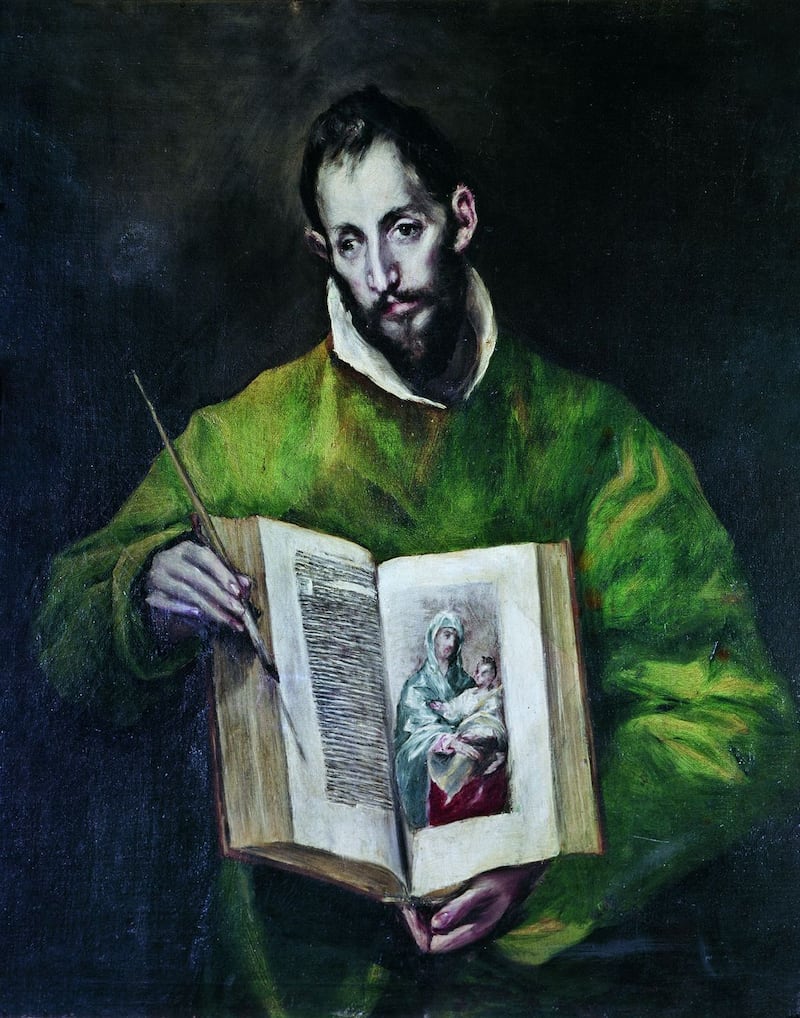
In Rome, Greco became friends with Luis de Castilla, the illegitimate son of a high-ranking Spanish churchman. De Castilla urged Greco to go to Spain, where King Philip II was recruiting artists to decorate the Escorial palace and monastery.
Philip commissioned Greco’s Adoration of the Holy Name of Jesus, which shows the Spanish king kneeling in the midst of a hallucinatory dream of heaven and hell, peopled by angels, church figures and damned souls writhing in torment in the mouth of a monster.
Guillaume Kientz, formerly of the Louvre, now curator of European Art at Kimbell Art Museum in Fort Worth and co-commissioner of the exhibition, notes that Philip II owned paintings by Hieronymus Bosch. He believes Greco saw them and was inspired by Bosch's nightmare of hell.
Greco gained a reputation for arrogance. Would his life have been different if he had been more diplomatic? 'He probably would not have been the same painter, and he probably couldn't help it'
Philip II then commissioned a Martyrdom of St Maurice. The Council of Trent was battling Protestantism in the Counter-Reformation, and ordered painters to limit themselves to sobre illustrations. The uncompromising Greco ignored his patron’s wishes, producing instead an elaborate narrative that Philip rejected.
Greco gained a reputation for arrogance. Would his life have been different if he had been more diplomatic? “He probably would not have been the same painter, and he probably couldn’t help it,” Kientz answers. “He followed his own path. It wasn’t easy, but it was better.”
Diego de Castilla, the dean of Toledo cathedral and the father of Greco’s friend Luis, signed a contract for the Assumption of the Virgin, seven other paintings and several sculptures. It was the 36-year-old migrant painter’s first big break.
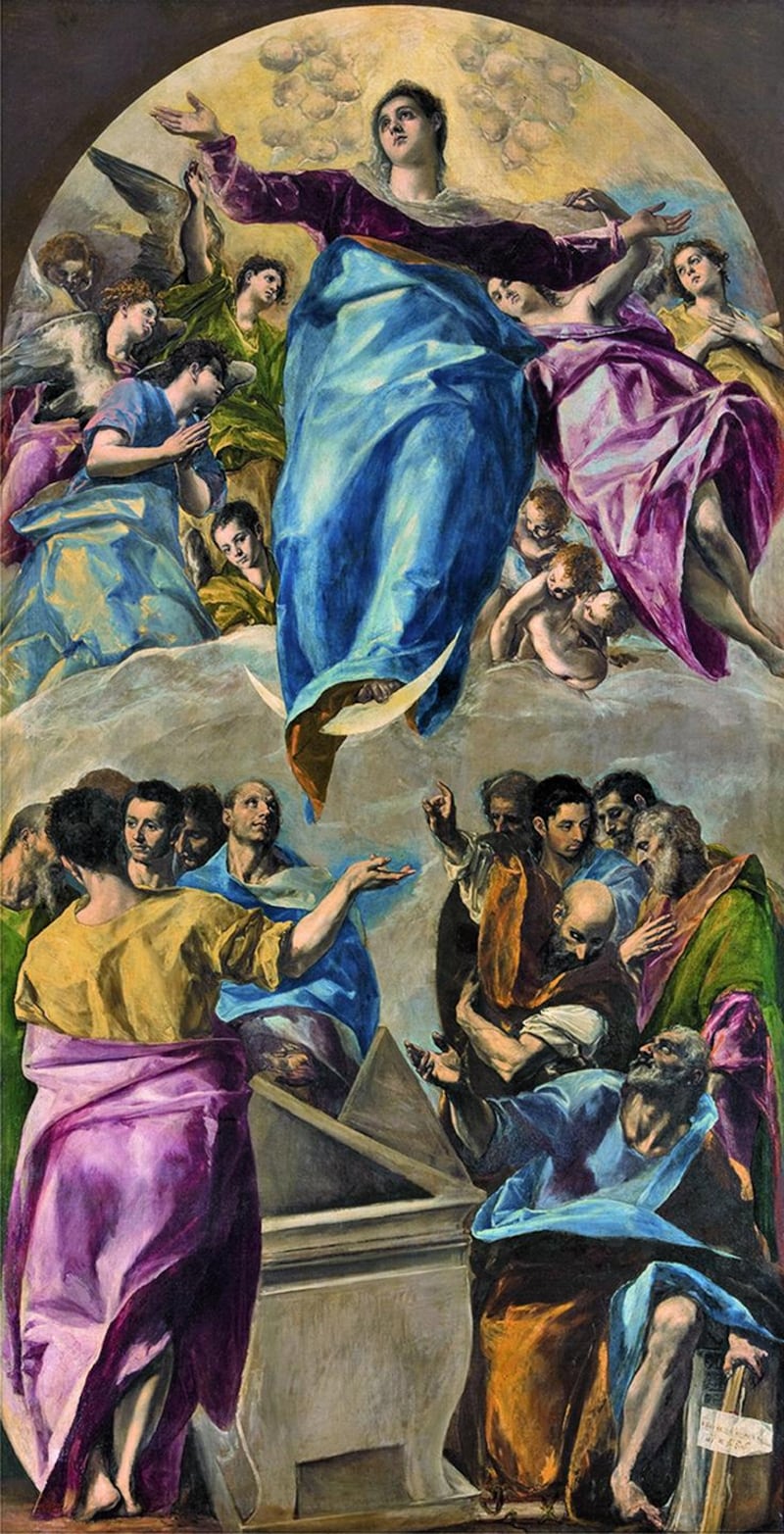
Though it was painted in Spain, Greco’s Assumption of the Virgin was in essence an Italian painting. Its composition resembles that of Titian’s Assumption in the Basilica des Frari in Venice, with Virgin and angels above and apostles below.
Renaissance Venetians constructed their paintings with colour. Florentines and Romans drew lines first, then filled in the colour. Greco sought to combine the two styles.
“Michelangeo was dead. Titian was very old. Greco saw himself as the artist of the future, who would carry the Renaissance forward,” says Kientz. In the Assumption of the Virgin, Kientz continues, “Greco best reconciled Titian’s colours with Michelangelo’s physical force and draughtsmanship. This matronly Virgin comes towards us with a terribilità reminiscent of Michelangelo’s Last Judgment.”
Greco's unique palette, and the tightly framed composition of the Pietà, make it one of his most unusual and moving paintings
Terribilità, or awesomeness, was the term used by Michelangelo’s contemporaries to describe his oeuvre. In the Assumption, Kientz says, “Greco shows everything he is capable of, how well he has learned from the great masters.”
The Greco retrospective also provides a rare opportunity to view Greco’s Pietà, inspired by Michelangelo’s Pietà Bandini. It belongs to a private collector and had not been seen in public for 37 years. The Pietà marks Greco’s transition from Italian style to a Spanish-influenced manner all his own, imbued with almost kinetic energy.
Greco’s unique palette, and the tightly framed composition of the Pietà, make it one of his most unusual and moving paintings. Christ’s arm falls towards the viewer. Greco placed his signature in the crown of thorns, to the left of Christ’s dead hand.
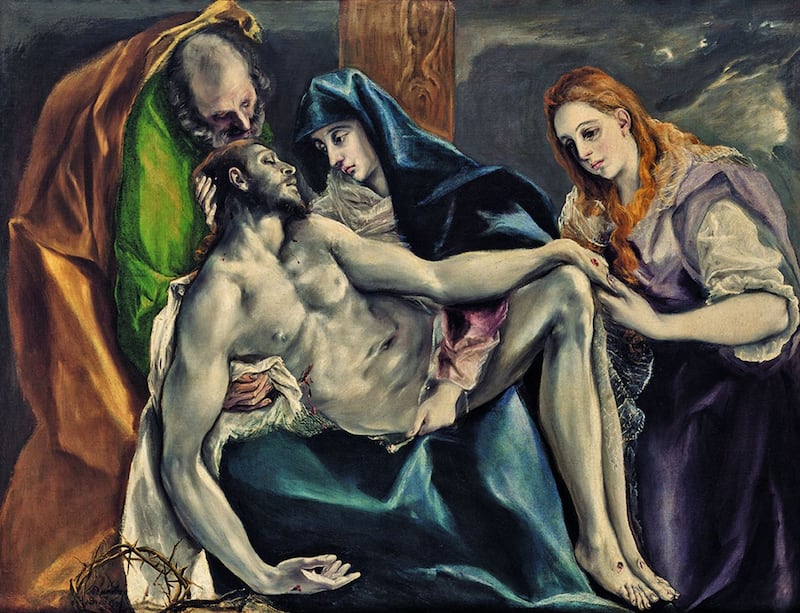
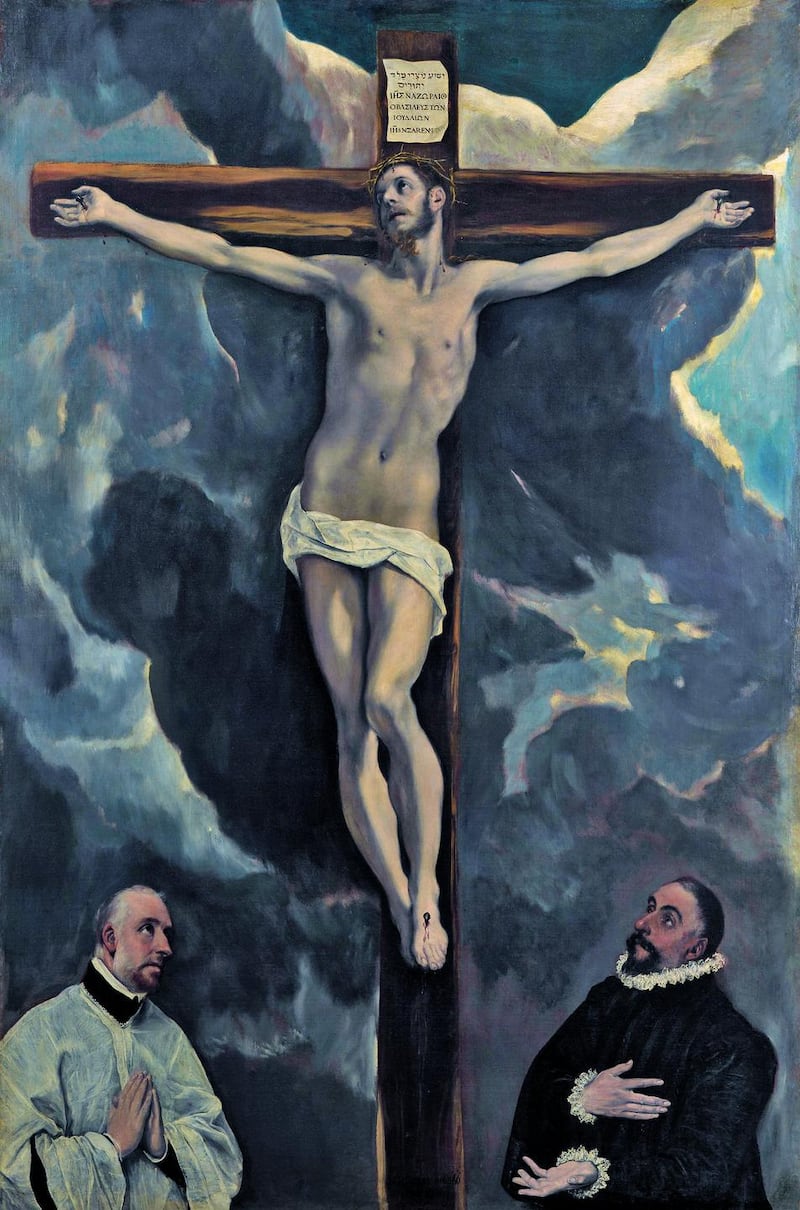
Details draw you into Greco’s paintings and hold you. The sky behind Christ on the Cross is a black, blue and grey vortex that threatens to crush you. The thorns are razor-sharp, the nail holes bitter. In the Adoration of the Shepherds, the Virgin crosses her hands on her chest with exquisite grace. In St Louis and a Page, the crusader king has the face of a French rock star.
After Greco painted the Burial of Count Orgaz in Toledo’s Church of Santo Tome, his atelier flooded the city with mass-produced, smaller replicas of his paintings. He earned a great deal of money, which he needed for expensive habits such as hiring musicians to play while he painted, and rent on a 24-room apartment in the palace of the Marquis of Villena.
Only two of Greco’s views of Toledo have survived, in Toledo and New York, but they were deemed too fragile to travel to Paris. The Alcázar, cathedral and Tagus river are nonetheless present, like ghostly stowaways in the background of Greco’s religious paintings.
Greco's approach was one of variation and perpetual reinvention. His oeuvre is like one big painting that he constantly dips into, comes back to
The exhibition shows how Greco revisited the same themes, but invented them anew each time. Christ on the Mount of Olives. Saint Francis at prayer. The apostles Peter and Paul. The Holy Family. Mary Magdalene.
“Through a series of paintings, Greco’s approach was one of variation and perpetual reinvention,” says Kientz. “His oeuvre is like one big painting that he constantly dips into, comes back to. In that way he most resembles the avant-garde painters who would rediscover him at the end of the 19th- and early 20th-centuries.”
Kientz and his fellow commissioner, Charlotte Chastel-Rousseau from the Louvre, secured the loan of all four versions of Christ Driving the Traders from the Temple, painted in 1570, 1575, 1600 and 1610-1614. The 1575 version, painted in Rome, includes portraits of Raphael, Michelangelo, Greco’s friend Giulio Clovio and Titian in the bottom right-hand corner.
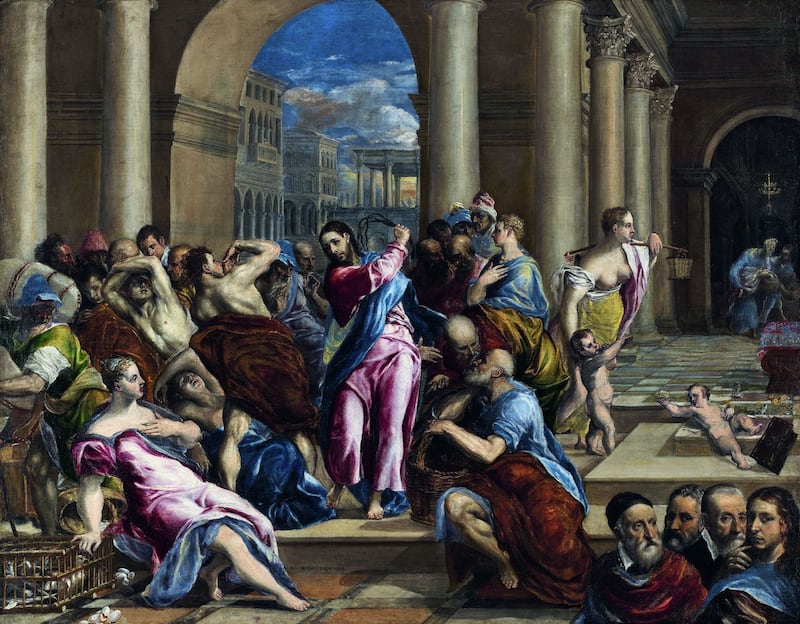
The series of Christs Driving the Traders, like the exhibition itself, shows how Greco evolved from Venetian to Roman to Spanish schools, ending with the style he is known for: what Jean Cocteau called “the divine decay of his colours”– elongated bodies, liquid eyes, ashen grey flesh.
There was something savage or wild in Greco’s painting, Kientz says, an unstoppable force. He quotes the title of a recent book, The Savage Renaissance by Guillaume Logé.
“For me, Greco is the savage Renaissance,” Kientz says. “It’s as if he slashed his way through the jungle of the Italian Renaissance with a machete and imposed his vision in Toledo. The older he grows, the wilder it becomes, and it ends with this magnificent Vision of Saint John from the Metropolitan.”
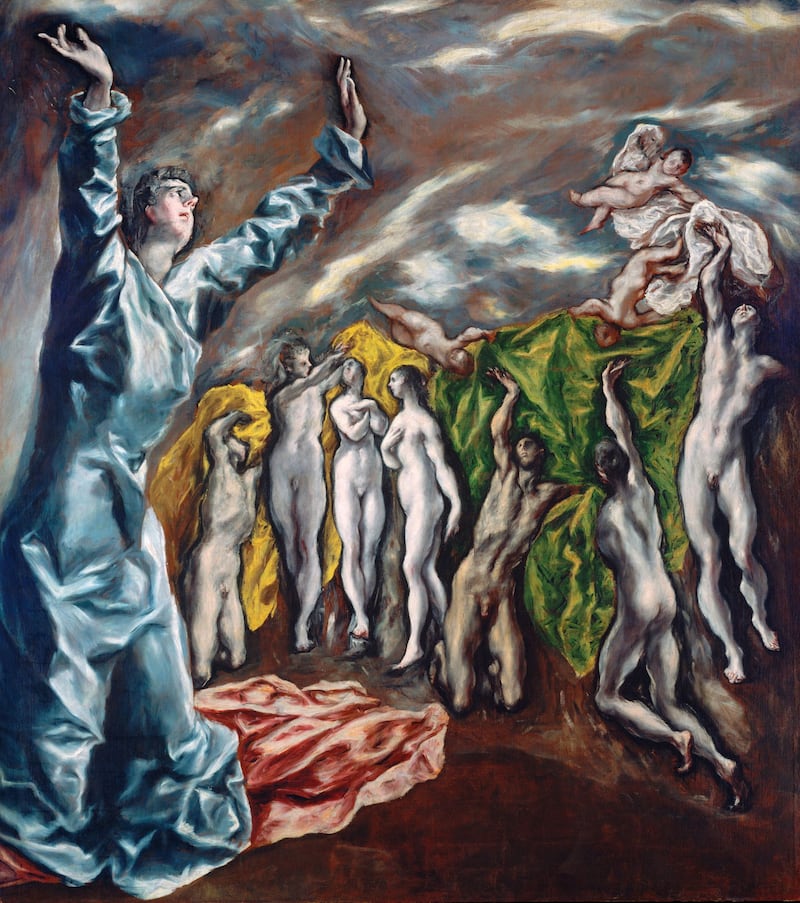
Greco was painting the unfinished Vision of St John when he died. It is the most feverish and electric of all his canvases. Based on Revelation 6:9-11, it evokes the end of time.
St John looms in the left foreground, kneeling and stretching his arms towards the sky. Naked bodies representing the saved strain for the white robes which reward “those who had been slain for the work of God and for the witness they had borne”.
Before our eyes, Greco has travelled 1,000 years in his 73-year lifespan, from a painter of medieval-style icons to what appears to us a thoroughly modern Vision of St John. The apocalypse as imagined by Greco became an icon to 20th-century painters, chief among them Cézanne and Picasso.
Greco is at the Grand Palais in Paris until February 10th, 2020















